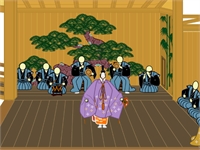
Japanese Culture: Noh Drama
Important Notice: Our web hosting provider recently started charging us for additional visits, which was unexpected. In response, we're seeking donations. Depending on the situation, we may explore different monetization options for our Community and Expert Contributors. It's crucial to provide more returns for their expertise and offer more Expert Validated Answers or AI Validated Answers. Learn more about our hosting issue here.

Japanese Culture: Noh Drama
You must be logged in to post a comment.
Tradition Japanese theater consists of four different types: bunraku, kabuki, kyogen, and noh. Noh is a type of dramatic play developed around the 14th century. It is one of the oldest types of theater in the world.
Noh contain a great deal of symbolism and often plays will reference classic literary pieces, Buddhist parables or Teachings, or Shinto beliefs and mythology. To truly appreciate Noh, having a basic understanding of such things would prove extremely helpful, though is not entirely necessary for surface-understanding.
The Noh Stage
The stage in Noh plays can be quite magnificent when first scene by foreigners. A typical stage is about six meters square and made of polished Cypress. There is often a roof, similar to those on Shinto Shrines, covering the stage, but if the performance is not in Japan such a setting may not be realistically available.
There is a bridge for the performers to enter and exit the stage, and the musicians and chorus will almost always be found seated (or kneeling) in the rear right area of the stage. There are usually three musicians, playing a flute, small and large hand drums (kotsuzumi and otsuzumi, respectively), with a forth as necessary, to play a large floor drum (taiko).
There is a pine tree painted on the wall to the back of the stage that will serve as the backdrop for all Noh plays performed. The setting of the play is made clear by the narration, dialogue, and songs of the play.
Noh Masks, Costumes, and Props
Masks are often used in Noh plays and can sometimes be found in museum collections. General character types such as an old man, young woman, demon, or others help project the emotions of the play. The main character of the play is usually the only one wearing a mask, but this can change depending on the play. Sometimes the same mask can be used to represent multiple feelings simply by shifting the mask’s position on the actor allowing shadows to create a different appearance.
The costumes of Noh plays are often quite extravagant, which stand out all the more when placed on the simple, yet beautiful, stage setting. The main character will often wear a five-layer wardrobe with a fancy brocade outer layer, and sometimes a red or white wig making their appearance, at times, striking.
The main character may utilize props to help express things with increased visual effect and emotional clarity. A common prop is a folding fan, which can be used to represent another object or to symbolize an action. Additional common props may be a sword or mallet, among other hand-held items, but also stage props such as a well, a boat, an altar, or bell.
The Actors
The main character is known as the shite. The waki are subordinate characters. If the shite has accompanying characters they are known as shitezure or simply tsure. Additionally, if the waki has accompanying characters they are known as wakizure or tsure.
If the play includes a child character, this is known as kokata and will not be wearing a mask.
Noh Play Classifications
There are typically five categories of Noh plays:
Jo-Ha-Kyuu in Noh Plays
Jo-ha-kyuu is found in much of the Japanese arts, and can be considered as “beginning”-“break”-“rapid/speed up.” In this sense, this describes the slow beginning of the Noh play, the break then acceleration and ending of the play. This “rapid ending” is only fast in comparison to the earlier portion of the play, however, and should not be considered as a rushed ending.
All aspects of the play are created with this jo-ha-kyuu concept incorporated into them, from the music and songs, to the movements and words of the actors.